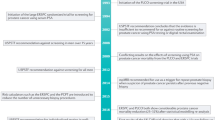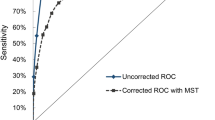Abstract
Background
Prostate-specific antigen (PSA) and prostate health index (PHI) have been used as biomarkers for prostate cancer detection. In this study, we aimed to evaluate the cost-effectiveness of PHI for prostate cancer detection in Chinese men.
Method
We developed a Markov model for Chinese male patient aged 50–75 years old. The PSA strategy was to offer TRUS-PB for all patients with elevated PSA of 4–10 ng/mL. The PHI strategy was to offer PHI for patients with elevated PSA of 4–10 ng/mL. TRUS-PB would only be offered for patients with PHI >35.0. Model inputs were extracted from local data when available. The cost per quality-adjusted life years gained for both strategies were calculated. The incremental cost-effectiveness ratios in relation to the willingness-to-pay (WTP) threshold were compared. One-way sensitivity analysis and probabilistic sensitivity analysis were performed. Cost-effectiveness acceptability curves were also constructed.
Results
With a Markov model of 25 screening cycles from age 50 to 75 years, the mean total costs per man were estimated to be USD 27,439 in the PSA strategy and USD 22,877 in the PHI strategy. The estimated effects were estimated to be 15.70 in the PSA strategy and 16.05 in the PHI strategy. The PHI strategy was associated with an expected decrease in cost of USD 4562 and an expected gain of 0.35 QALY, resulting in an ICER of USD −13056.56. The results were shown to be robust upon one-way sensitivity analysis. Upon Monte Carlo simulation, the PHI strategy was more cost-effective for 100% of the iterations. The PHI strategy demonstrated dominance over the PSA strategy regardless of what WTP threshold we use.
Conclusions
A PHI-based screening strategy may be more cost-effective than a PSA-based strategy for prostate cancer detection in Chinese men. These results support consideration of a PHI-based approach for prostate cancer in Hong Kong.
This is a preview of subscription content, access via your institution
Access options
Subscribe to this journal
Receive 4 print issues and online access
$259.00 per year
only $64.75 per issue
Buy this article
- Purchase on Springer Link
- Instant access to full article PDF
Prices may be subject to local taxes which are calculated during checkout



Similar content being viewed by others
References
Catalona WJ, Smith DS, Ratliff TL, Dodds KM, Coplen DE, Yuan JJ, et al. Measurement of prostate-specific antigen in serum as a screening test for prostate cancer. N Engl J Med. 1991;324:1156–61.
Teoh JY, Yuen SK, Tsu JH, Wong CK, Ho BS, Ng AT, et al. The performance characteristics of prostate-specific antigen and prostate-specific antigen density in Chinese men. Asian J Androl. 2017;19:113–6.
Teoh JY, Yuen SK, Tsu JH, Wong CK, Ho B, Ng AT, et al. Prostate cancer detection upon transrectal ultrasound-guided biopsy in relation to digital rectal examination and prostate-specific antigen level: what to expect in the Chinese population? Asian J Androl 2015;17:821–5.
Catalona WJ, Richie JP, Ahmann FR, Hudson MA, Scardino PT, Flanigan RC, et al. Comparison of digital rectal examination and serum prostate specific antigen in the early detection of prostate cancer: results of a multicenter clinical trial of 6,630 men. J Urol 1994;151:1283–90.
Bill-Axelson A, Holmberg L, Garmo H, Rider JR, Taari K, Busch C, et al. Radical prostatectomy or watchful waiting in early prostate cancer. N Engl J Med 2014;370:932–42.
Catalona WJ, Partin AW, Sanda MG, Wei JT, Klee GG, Bangma CH, et al. A multicenter study of [-2]pro-prostate specific antigen combined with prostate specific antigen and free prostate specific antigen for prostate cancer detection in the 2.0 to 10.0 ng/ml prostate specific antigen range. J Urol 2011;185:1650–5.
Chiu PK, Roobol MJ, Teoh JY, Lee WM, Yip SY, Hou SM, et al. Prostate health index (PHI) and prostate-specific antigen (PSA) predictive models for prostate cancer in the Chinese population and the role of digital rectal examination-estimated prostate volume. Int Urol Nephrol. 2016;48:1631–7.
Force USPST. Screening for prostate cancer: U.S. Preventive Services Task Force recommendation statement. Ann Intern Med 2008;149:185–91.
Census and Statistics Department, Hong Kong Special Administrative Region. Hong Kong Life Tables 2011–2066. https://www.statistics.gov.hk/pub/B1120016072017XXXXB0100.pdf. Accessed 01 Jan 20.
Choosing Interventions that are Cost Effective (WHO-CHOICE). 2014. Available at: http://www.who.int/choice/costs/CER_levels_en. Accessed 8 May 2014.
Hogendoorn W, Moll FL, Sumpio BE, Hunink MG. Clinical decision analysis and markov modeling for surgeons: an introductory overview. Ann Surg 2016;264:268–74.
The Hong Kong Cancer Registry, Hospital Authority. Enquiry on Cancer Statistics [Available from: http://www3.ha.org.hk/cancereg/e_b1.asp.
Teoh JYC, Hirai HW, Ho JMW, Chan FCH, Tsoi KKF, Ng CF. Global incidence of prostate cancer in developing and developed countries with changing age structures. PLoS One. 2019;14:e0221775.
Bouttell J, Teoh J, Chiu PK, Chan KS, Ng CF, Heggie R, et al. Economic evaluation of the introduction of the Prostate Health Index as a rule-out test to avoid unnecessary biopsies in men with prostate specific antigen levels of 4-10 in Hong Kong. PLoS One. 2019;14:e0215279.
Heijnsdijk EA, Denham D, de Koning HJ. The cost-effectiveness of prostate cancer detection with the use of prostate health index. Value Health 2016;19:153–7.
Nichol MB, Wu J, Huang J, Denham D, Frencher SK, Jacobsen SJ. Cost-effectiveness of Prostate Health Index for prostate cancer detection. BJU Int. 2012;110:353–62.
Chiang CL, So TH, Lam TC, Choi HCW. Cost-effectiveness analysis of Abiraterone Acetate versus Docetaxel in the management of metastatic castration-sensitive prostate cancer: Hong Kong’s perspective. Prostate Cancer Prostatic Dis. 2020;23:108–15.
Choi HCW, Jit M, Leung GM, Tsui KL, Wu JT. Simultaneously characterizing the comparative economics of routine female adolescent nonavalent human papillomavirus (HPV) vaccination and assortativity of sexual mixing in Hong Kong Chinese: a modeling analysis. BMC Med. 2018;16:127.
Wong IO, Kuntz KM, Cowling BJ, Lam CL, Leung GM. Cost effectiveness of mammography screening for Chinese women. Cancer. 2007;110:885–95.
Acknowledgements
This study was supported by the Health Medical and Research Fund – Research Fellowship Scheme 2017/18 (Reference No.: 02160047).
Author information
Authors and Affiliations
Corresponding author
Ethics declarations
Conflict of interest
The authors declare that they have no conflict of interest.
Additional information
Publisher’s note Springer Nature remains neutral with regard to jurisdictional claims in published maps and institutional affiliations.
Rights and permissions
About this article
Cite this article
Teoh, J.YC., Leung, CH., Wang, M.H. et al. The cost-effectiveness of prostate health index for prostate cancer detection in Chinese men. Prostate Cancer Prostatic Dis 23, 615–621 (2020). https://doi.org/10.1038/s41391-020-0243-1
Received:
Revised:
Accepted:
Published:
Issue Date:
DOI: https://doi.org/10.1038/s41391-020-0243-1



